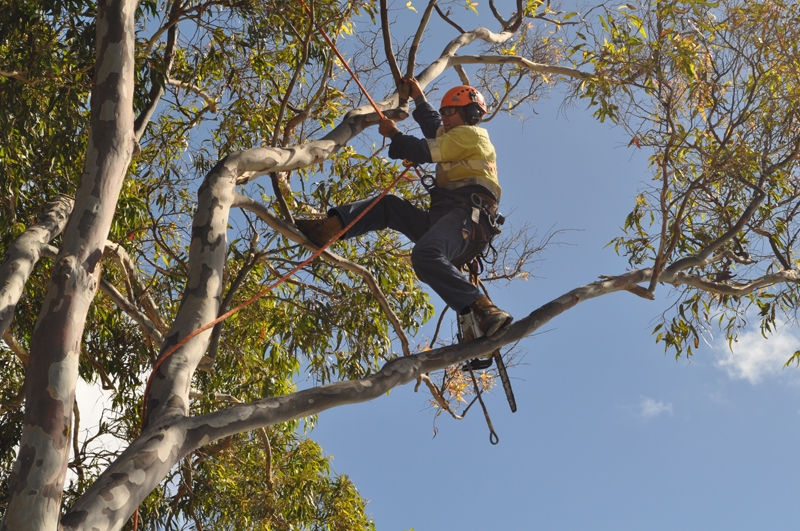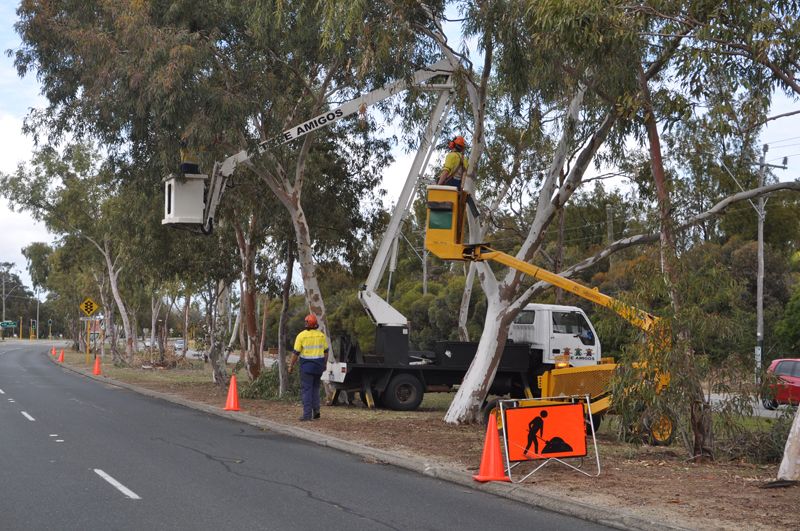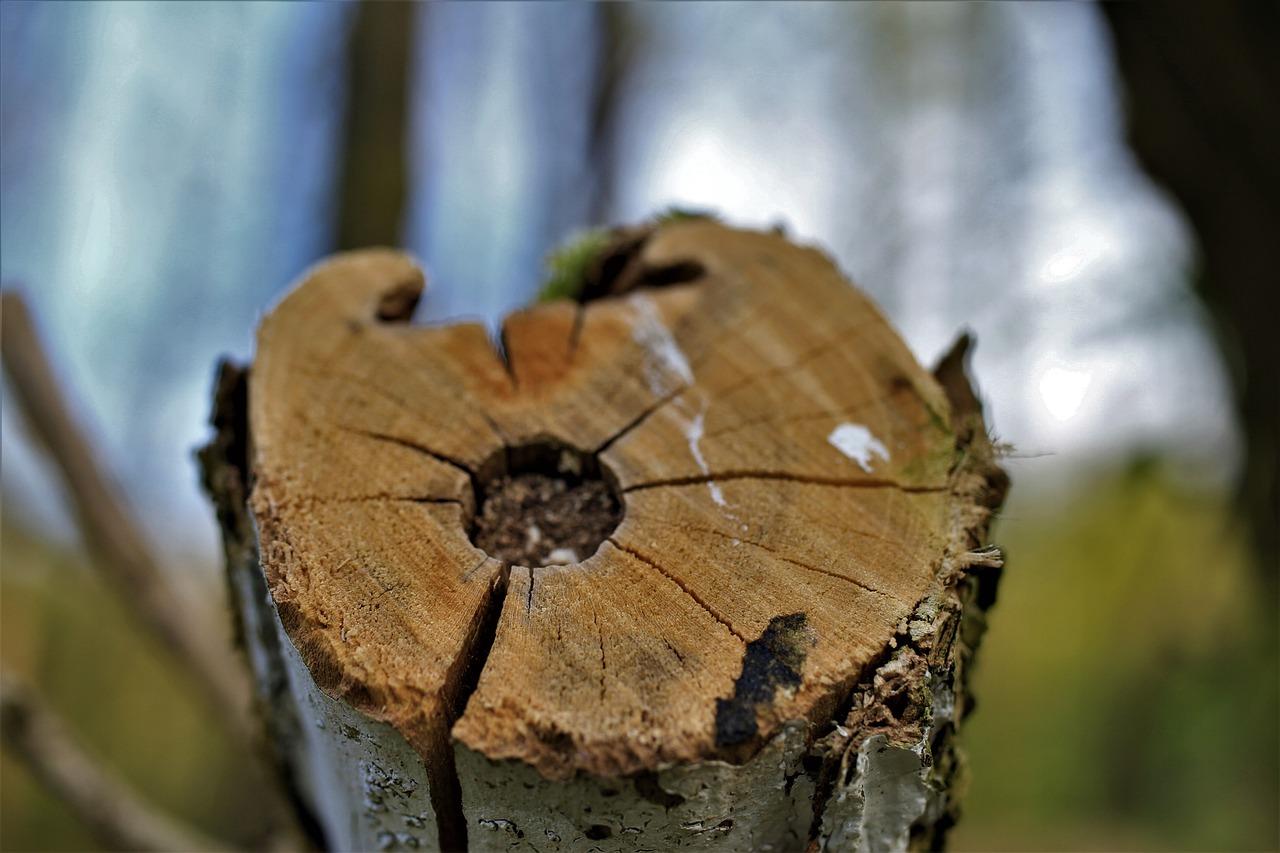To avoid injury, it is best to leave the task of down a large tree to those who have the necessary training and equipment. If you are unable to hire a professional and must cut down the tree yourself, the following tree cutting tips may prove useful.
Tree felling is a dangerous job that should only be attempted by experienced professionals. If you don't have the funds to employ a pro, though, you can save money by doing it yourself with the help of some guides and tutorials. Always remember that safety is priority number one, no matter how big the tree is. Here, then, are some methods and pointers for cutting down trees that should make the job easier.
Why Cut Your Tree?
Safety
The primary reason to have your tree trimmed is for safety reasons. Trees in the front or back yard add beauty and value to a house, but they also pose a risk if they aren't cared for properly. Branches and limbs can perish at any time, and the smallest breeze can cause the detached parts to fall. The branches of trees can potentially be a hazard to power lines.
Safety Of Trees
In certain cases, removing diseased branches from an infected tree will restore it to full health. The health of a tree can be improved by decreasing its crown and allowing more light and air to reach the tree's roots.
The Way It "Looks"
Now let's discuss how your tree and house together will look from the outside. Nobody likes staring at an unsightly tree in their yard, which is why annual or biannual pruning is recommended.
Acquire Necessary Tools
A tree service company's education in technique begins with the acquisition of suitable tools. You should also make sure that all of your tools are in working order and have tested them before using them on a tree. The following is a list of the most important tools you'll need to remove a large tree from your property.
Chainsaw
One may argue that this is the single most crucial tool you'll require. The chainsaw's bar length should be 20 inches, and it should have roughly 3.5 horsepower. Given that the blade's cutting capacity is proportional to the length of the bar, a depth of 20 inches should be sufficient for felling most trees.
Anti-Impact Glasses
When undertaking labour of this nature, many people fail to realise the significance of wearing protective eyewear. When using a chainsaw, though, you risk serious injury to your eyes from flying debris.
Leg Guards
The saw might kick out of the tree, hitting you in the leg if you strike a knot. Knee-high safety boots or other substantial leg protection is advised.
A Rope With A Tensile Strength Of 1000 Lb
You should have a rope that is about three times as long as your tree is tall. It'll be kept on hand as a failsafe in case something goes wrong. Before you begin, check the condition of all of your tools to ensure you'll have everything you need. You should get some buddies to come over and help if at all possible. They will not only be able to guide the tree's fall, but they will also be there in case of an emergency. It's not a good idea to cut down a tree on your own, but if you must, you should check to see whether there's a chance it could fall on anything but the ground. If the tree is close to your home, fence, or even worse, your neighbour's property, you should not take it down. When you're ready, follow these procedures to securely fell your tree.
Cutting Down Trees: A Step-By-Step Guide
Create A Safe Slicing Area
Even if you know exactly how the tree will fall, that doesn't mean you're prepared to cut it down. Clear the area around the tree's base and create two escape routes on the "non-falling" side of the tree. They need to face in different directions, at an angle of around 45 degrees. A falling tree is a dangerous situation in which you definitely don't want to trip over anything.
Imagine Potential Pitfalls
Preparation is the key to success when using a chainsaw to fell a tree. Planning the felling and deciding which forestry equipment to bring can provide for a safer working session and less backbreaking labour after the trees have been cut down. You should check for large obstructions like power lines, roads, or buildings before proceeding. Next, put up caution signs if a road cuts through the forest or if a high volume of traffic regularly passes by the region.
The trunk's "fall" side is where you'll be making your notch. Adjust the saw so that the blade is facing in the direction you want to fall by aligning the sight with the handle. The centre of the notch will be at the point where the bar meets the bark. Mark the location of the notch with chalk or a chainsaw before beginning to cut. If necessary, the stump can be shortened once the notch has been made.
Get A Feel For The Tree
Check out the tree first. If you see, don't shorten it:
- Fragmented but still attached dead branches or those that have broken off but are still being held up by other branches. Inevitably, you'll disturb a branch, and then it'll fall on you.
- It's plainly slanted or has a heavier burden of branches on one side. Despite your greatest efforts, it will tumble in the direction of the lean or load.
- The felling zone contains structures, fences, electricity wires, or other objects of importance to you. If that's the case, you should probably just hire someone to do the felling for you.
Inspect The Axis Of Falling
Next, analyse the tree to find the best direction for felling. What do the limbs look like and how do they develop? You should think about the way the wind is blowing as well. Get some distance away from the tree and use a plumbline to determine which way gravity is pulling it (see fact box for details). Then, make a circle around the tree in the direction you plan to cut it down. You should also make a corridor of retreat by clearing a space behind the tree at an angle of roughly 45 degrees in both directions.
Cut Down The Tree
Once you've cleared the area and posted your warning signs, you can figure out where the tree will fall and where to make a hasty exit. Next, ensure that you have sufficient gasoline for the upcoming activity. Next, the trunk must be pruned to remove any branches or twigs that could obstruct the felling cut with a chainsaw. Pruning should be done from the top down using a pulling chain (the underside of the guide bar) for maximum safety.
Identify The Method Of Slicing To Use.
The felling cut should be made when the tree trunk is clear of branches to the shoulder level. The hinge must be of uniform thickness and the proper size, and the felling wedge or breaking bar must be placed before the tree may pinch the guide bar. Determine the best method for making the cut based on the tree's height, angle, and diameter, as well as the length of your chainsaw. Here, we outline the various approaches so you may determine which one is best suited to your circumstances. /insert a link to the relevant section of "working with chainsaws."
The Components Of A Perfect Notch
The general rule of thumb for notch depth when felling a tree is to make it equal to one-fifth of the trunk's diameter. The angle requirements are depicted in the diagram, and must be met (or as close as you can). The tip of the notch should line up with the felling cut. The hinge will assist in directing the tree's fall in the appropriate direction as it begins to topple.
Inspect For Illnesses
Be extremely cautious if you find that the wood has changed colour and become mushy, or if the base of the trunk appears swollen or infected. The presence of rot is a sign that the tree's wood fibres have been compromised. In this case, you should fall in the tree's natural direction of fall and, if necessary, employ the usage of a winch. Since rot tends to dissipate farther up a tree, leaving a taller stump after cutting it down could be an alternative.
Find The Tree's Height
The second method for felling trees is this one. Decide where to fall from the tree after you know how high it is. Hopefully, you've already cleaned up the area around the intended drop off point. If you haven't already done so, you should before you begin to cut.
Reduce the Gap
The top should be taken off first, followed by the bottom. If you want to do a bottom cut, you should move your thumb to the throttle. When the top notch is precisely aligned, the wedge will fall out. In most cases, however, you'll need to deepen the slits at the top or the bottom for the wedge to release and fall to the ground.
Create Some Loops
Make sure your knots at the top of the tree trunk are secure by using your ropes. Construct as many secure knots as you'd like, and then have your pals hold the other end. Tell them to wait outside the drop zone at a safe distance.
The tree will be dragged in the desired direction after it is cut down. The rope method is crucial because it allows you to direct the tree's fall to a certain location.
Create A Crisscrossing V With A Pair Of Scissors.
A V-shaped notch cut into the side of the tree towards the desired direction of fall will ensure a soft landing. Trimmed to fall just above the knee on a normal-sized individual. Both the top and bottom points of this V-shaped cut should meet in the middle of the tree.
Invoke a Back Cut
Once you've completed one V-shaped cut, proceed to the other side of the tree and do the same thing. Make this cut about 3 inches from where the V will meet the bottom. Make the backslash reach almost to the centre, but stop short of the V'd tip up front. The wedge cut in the tree's back causes it to buckle and begin to collapse.
Pull
The tree will begin to fall when the rear cut has been performed. If you and your buddies have ropes, you can tug it in the appropriate way. That wraps up the fundamentals of tree cutting for amateurs. Of course, that's not all you'll need to know; you'll also want to familiarise yourself with some basic safety procedures.
Big Trees Need Wedge Cutters
Make your notch cut and start the felling cut if the tree's diameter is more than 18 inches. As soon as you've gotten far enough in to pound wedges behind the bar, you should stop cutting. Don't remove the bar from the cut until you've locked the chain brake and tapped in the wedges. If you've already started cutting, stop. If the tree leans back during the cut, the use of wedges will prevent the saw from becoming pinched.
An Observation Post Could Be a Lifesaver.
You should have a reliable helper stand a few feet behind you when felling a tree to check for falling limbs and alert you when the tree itself begins to fall. When it's time to leave, have your helper tap you on the shoulder with a stick. If you get the tap when still in the preliminary stages of a cut, put down the saw and get out of there. When you hear that, you know a branch is about to crash to the ground. An approaching tap at the end of a cut indicates that the tree is starting to fall.
Guidelines For Pruning And Cutting Trees Safely
To start, you are under no obligation to perform the tree cutting yourself, especially if you lack the necessary skills and/or equipment. A professional arborist can assist you with this. If, on the other hand, you believe you are prepared to embark, then remember the following, notably the things you must not do.
- Don't hide behind one, even though it seems harmless given that the tree is plunging away from you.
- Well, a tree's stump can break off, sending the entire tree kicking back in your direction at a pace you might not be able to predict. What harm this can do to a person's psyche is best off unspoken.
- Don't go near a tree that you've already lopped off: If you have cut yourself in a V shape in the front and in the back, move out of the way.
- If the tree still doesn't come crashing down after you've made these cuts, leave it alone and don't go near it with your saw. The weight will soon become apparent now that it has been cut. By the time it happens, you may already be too late.
- Having a professional tree cutting firm or arborist do the job for you is strongly suggested. However, if you're set on handling things on your own, consider the following guidelines. Additional information on tree felling and cutting is provided.
- Stay away from the backside of a toppling tree. If the stump breaks, the tree will kick back at you, perhaps causing serious harm.
- If the tree won't come crashing down, you shouldn't go near it with a chainsaw. It can be moved by the rope alone. There is a lot of weight on the tree, and it can break.
- If you discover that your tree's branches are touching electrical wires, you should not attempt to remove the tree on your own.
Calling the proper authorities to come take a look at the problem is an absolute requirement in a predicament like that. A hero would not risk electrocution by cutting the branches away from the power line.
Conclusion
It is preferable to hire a professional tree service if you need a huge tree removed. The following tree-felling advice may come in handy if you are unable to get a professional to cut down the tree for you. You'll need a chainsaw and safety glasses most of all. Felling a tree with a chainsaw requires careful planning to ensure a smooth operation. Inspect your equipment to make sure you have everything you need before you get started.
Wearing safety boots that reach at least your knees is recommended. Determine where the tree is leaning and in what direction it will fall first. The next step is to check the trunk for any twigs or branches that might stick out and cause an obstruction. At shoulder height, the tree trunk should be free of branches before the felling cut is done. A uniformly thick and appropriately sized hinge is essential, as is positioning the felling wedge or breaking bar ahead of the guide bar so that the tree doesn't pinch it.
Once you've determined how high the tree is, you may choose where to jump from there. The ability to control where the tree falls by means of the rope approach is vital. For a gentle touch down, cut a V-shaped slot into the tree's side. Use of wedges will protect the saw from being pinched if the tree leans back during the cut. No pressure to do the tree work yourself if you don't have the know-how or resources to do it safely and efficiently.
Seek the help of an expert arborist for this. Don't take refuge in the safety of a tree, no matter how far away it seems to be swaying. Avoid standing behind a falling tree. The tree could cause major injury if it kicks back at you if the stump breaks. Avoid attempting tree removal on your own if you find that any of its branches are contacting any nearby electrical cables.
Content Summary
- It's important to let professionals with the right gear and experience take down big trees so no one gets hurt in the process.
- The following are some things to keep in mind if you're going to be chopping down a tree yourself instead of hiring a professional.
- Having your tree pruned should be done primarily for safety reasons.
- And before you go hacking away at a tree, check that every one of your tools is in tip-top shape.
- Here is a rundown of the primary implements required to chop down a sizable tree in your yard.
- Many people don't think about the importance of protecting their eyes when doing work like this.
- Wearing safety boots that reach at least your knees is recommended.
- Inspect your equipment to make sure you have everything you need before you get started.
- It's not wise to fell a tree on your own, but if you must, be sure nothing will be damaged if the tree falls.
- If you're ready to take down a tree, here are some steps to take to ensure its safe removal.
- You should clear the ground around the tree's base and make two escape routes on the "safe" side of the tree.
- Felling a tree with a chainsaw requires careful planning to ensure a smooth operation.
- Before continuing, make sure there aren't any major obstacles in the way, such electrical lines, roads, or buildings.
- The "fall" side of the trunk is where you want to cut your notch.
- The intersection of the bar and the bark is the geometrical focus of the notch.
- Before beginning to cut, mark the spot where the notch will be using chalk or a chainsaw.
- After that, you need to inspect the tree to determine the safest and most efficient approach to cutting it down.
- Then draw a ring around the tree facing the direction in which you intend to fell it.
- You can now see where the tree will fall and where to make a quick departure once you've cleared the area and set your warning signs.
- The next step is to trim the tree's trunk so that no branches or twigs will get in the way of the chainsaw's felling cut.
- To minimise risk, prune from the top down using a pulling chain attached to the bottom of the guide bar.
- When the tree trunk is clean of branches to about shoulder height, you can make the felling cut.
- A uniformly thick and appropriately sized hinge is essential, as is positioning the felling wedge or breaking bar ahead of the guide bar so that the tree doesn't pinch it.
- Think about the height, angle, and diameter of the tree, as well as the length of your chainsaw, to come up with a plan for making the cut.
- When determining the depth of a notch to use in a tree's felling, it is common practise to use a value equal to one-fifth of the trunk's diameter as a guide.
- The notch's pointer must meet the felling cut.
- This is the alternative way of cutting down trees.
- Once you've determined how high the tree is, you may choose where to jump from there.
- Make sure the knots you tie at the top of the tree trunk are tight.
- Use the scissors to make a V shape with the blades crisscrossing.
- If you want to land safely, cut a V-shaped notch into the tree's side facing the direction you plan to fall.
- Following the first V-shaped incision, move to the opposite side of the tree and repeat the process.
- After the tree has had a wedge cut through its back, the tree will begin to crumble and eventually fall.
- Having ropes means you and your friends can pull it the right direction.
- And with that, we've covered all a beginner needs to know about tree cutting.
- If the tree's diameter is more than 18 inches, make the notch cut and begin the felling cut.
- When felling a tree, it's a good idea to have a trustworthy helper stand a few steps behind you to watch for tumbling branches and warn you if the tree starts to topple.
- Have your assistant tap you on the shoulder with a stick to indicate when it's time to leave.
- Put down the saw and leave the area if you get the tap while you're still in the earliest phases of a cut.
- The tree is beginning to topple when the cutter's final tap comes close by.
- First off, you are not required to cut down the tree yourself, especially if you do not have the appropriate training and/or tools.
- Seek the help of an expert arborist for this.
- However, if you think you're ready to set out, keep in mind the following, especially the things you absolutely must not do.
- Even if it looks safe since the tree is leaning away from you, you shouldn't take shelter behind it.
- You shouldn't approach a felled tree: If you have made a V-shaped incision in both your front and back, you should get out of the way.
- Even if the tree doesn't fall after you make these cuts, you should still give it some space and refrain from further sawing at it.
- Hiring a professional tree service or arborist to handle the work for you is highly recommended.
- Nonetheless, if you insist on taking matters into your own hands, you might want to think about the advice below.
FAQs About Tree Cutting Techniques & Tips
Whenever possible, stand on the uphill side of the tree. Work from the left side of the trunk (as you face toward the top of the tree). This allows the safest and most efficient use of the chain saw because you can rest the side or bottom of the saw on the trunk and slice off the branches with a pivoting motion.
Cut an open-face notch on the side of the tree that faces the direction you want the tree to fall. Make your top cut first. Begin your top cut at any height on the tree above the ground, allowing enough room for the undercut. First cut should be downward at an angle of 70°.
There are two stages of killing a tree. First, the tree should be pulled out entirely. Its roots are to be exposed to the sun and the air. Secondly, the roots are to be scorched in the sun.
The Cross-cutting Technique. To stop your chainsaw from getting stuck, make a cut on top of the log or tree that's preferably one-third of the log's diameter. Use your chainsaw to cut from the underside until you meet the initial top cut. Always stand on the side when cross-cutting to prevent injury.
Pruning is the removal, close to the branch collar, of side branches and multiple leaders from a standing tree. It is widely practiced to simulate natural branch mortality and increase the timber quality of selected trees.




